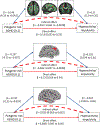Mapping associations between polygenic risks for childhood neuropsychiatric disorders, symptoms of attention deficit hyperactivity disorder, cognition, and the brain
- PMID: 30700802
- PMCID: PMC6667324
- DOI: 10.1038/s41380-019-0350-3
Mapping associations between polygenic risks for childhood neuropsychiatric disorders, symptoms of attention deficit hyperactivity disorder, cognition, and the brain
Abstract
There are now large-scale data on which common genetic variants confer risk for attention deficit hyperactivity disorder (ADHD). Here, we use mediation analyses to explore how cognitive and neural features might explain the association between common variant (polygenic) risk for ADHD and its core symptoms. In total, 544 participants participated (mean 21 years, 212 (39%) with ADHD), most with cognitive assessments, neuroanatomic imaging, and imaging of white matter tract microstructure. We found that polygenic risk for ADHD was associated with symptoms of hyperactivity-impulsivity but not inattention. This association was mediated across multiple PRS thresholds by white matter microstructure, specifically by axial diffusivity of the right corona radiata, (maximum indirect effect β = -0.034 (CI: -0.065 to -0.01), by thickness of the left dorsomedial prefrontal (β = -0.029; CI: -0.061 to -0.0047) and area of the right lateral temporal cortex (β = 0.024; CI: 0.0034-0.054). In addition, modest serial mediation was found, mapping a pathway from polygenic risk, to white matter microstructure of the anterior corona radiata, then cognition (working memory, focused attention), and finally to hyperactivity-impulsivity (working memory β = -0.014 (CI: -0.038 to -0.0026); focused attention β = -0.011 (CI: -0.033 to -0.0017). These mediation pathways were diagnostically specific and were not found for polygenic risk for ASD or schizophrenia. In conclusion, using a deeply phenotyped cohort, we delineate a pathway from polygenic risk for ADHD to hyperactive-impulsive symptoms through white matter microstructure, cortical anatomy, and cognition.
Conflict of interest statement
All authors declare no conflict of interest.
Figures


Similar articles
-
White matter microstructure is associated with hyperactive/inattentive symptomatology and polygenic risk for attention-deficit/hyperactivity disorder in a population-based sample of adolescents.Neuropsychopharmacology. 2019 Aug;44(9):1597-1603. doi: 10.1038/s41386-019-0383-y. Epub 2019 Apr 6. Neuropsychopharmacology. 2019. PMID: 30952157 Free PMC article.
-
Longer screen time utilization is associated with the polygenic risk for Attention-deficit/hyperactivity disorder with mediation by brain white matter microstructure.EBioMedicine. 2022 Jun;80:104039. doi: 10.1016/j.ebiom.2022.104039. Epub 2022 May 1. EBioMedicine. 2022. PMID: 35509143 Free PMC article.
-
Associations of polygenic risk scores differentiating attention-deficit hyperactivity disorder from autism spectrum disorder with cognitive and cortical alterations in Schizophrenia patients.Eur Child Adolesc Psychiatry. 2025 Mar;34(3):1149-1159. doi: 10.1007/s00787-024-02549-w. Epub 2024 Aug 7. Eur Child Adolesc Psychiatry. 2025. PMID: 39110189 Free PMC article.
-
[Structural and functional neuroanatomy of attention-deficit hyperactivity disorder (ADHD)].Encephale. 2009 Apr;35(2):107-14. doi: 10.1016/j.encep.2008.01.005. Epub 2008 Jul 7. Encephale. 2009. PMID: 19393378 Review. French.
-
The influence of sex-linked genetic mechanisms on attention and impulsivity.Biol Psychol. 2012 Jan;89(1):1-13. doi: 10.1016/j.biopsycho.2011.09.011. Epub 2011 Oct 6. Biol Psychol. 2012. PMID: 21983394 Free PMC article. Review.
Cited by
-
Genetics in the ADHD Clinic: How Can Genetic Testing Support the Current Clinical Practice?Front Psychol. 2022 Mar 8;13:751041. doi: 10.3389/fpsyg.2022.751041. eCollection 2022. Front Psychol. 2022. PMID: 35350735 Free PMC article. Review.
-
Working memory and reaction time variability mediate the relationship between polygenic risk and ADHD traits in a general population sample.Mol Psychiatry. 2022 Dec;27(12):5028-5037. doi: 10.1038/s41380-022-01775-5. Epub 2022 Sep 23. Mol Psychiatry. 2022. PMID: 36151456 Free PMC article.
-
Patterns of stressful life events and polygenic scores for five mental disorders and neuroticism among adults with depression.Mol Psychiatry. 2024 Sep;29(9):2765-2773. doi: 10.1038/s41380-024-02492-x. Epub 2024 Apr 4. Mol Psychiatry. 2024. PMID: 38575805 Free PMC article.
-
Behavioural Measures of Infant Activity but Not Attention Associate with Later Preschool ADHD Traits.Brain Sci. 2021 Apr 21;11(5):524. doi: 10.3390/brainsci11050524. Brain Sci. 2021. PMID: 33919004 Free PMC article.
-
NRN1 epistasis with BDNF and CACNA1C: mediation effects on symptom severity through neuroanatomical changes in schizophrenia.Brain Struct Funct. 2024 Jun;229(5):1299-1315. doi: 10.1007/s00429-024-02793-5. Epub 2024 May 9. Brain Struct Funct. 2024. PMID: 38720004 Free PMC article.
References
Publication types
MeSH terms
Grants and funding
LinkOut - more resources
Full Text Sources
Medical

